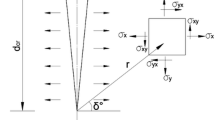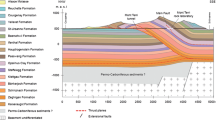Abstract
In the present study, a numerical modeling of moisture distribution under real climate conditions within sandstone monoliths is accomplished, based on detailed material-specific transport and storage functions. The impact of lithology and pore-radii distributions is modeled with consideration of (1) the single sandstone monolith; (2) the sandstone monolith with clay layers; and (3) the sandstone monolith with clay layers and hydrophobic treatment. The results reveal that the unimodal equal pore-radii distribution of the quartz arenite promotes quickly a (capillary) water uptake during driving rain (liquid stage), but due to its missing smaller capillaries a high drying velocity leads to an almost dry pore space, since moisture can only be absorbed via gaseous stage (e.g. during summer). On the contrary, the sublitharenite with a unimodal unequable pore-radii distribution is characterized by a distinctly higher water content, since in addition smaller pores also allow the absorption of moisture via sorption. Moreover, the high clay content promotes a retarded interaction with the environment, which is also reflected by the high vapor-diffusion resistance. The highest water content shows the feldspathic litharenite with highest clay content and bimodal pore size distribution. Here, over nine magnitudes of water transporting pores is involved at water transport and storage. Results also reveal that moisture accumulations during droughts trace the deterioration shape of rounding. For all sandstones highest annual fluctuations are observable within the rim zone of the monolith, while the center is characterized by more stable moisture content, which mainly depends on rising water content of the bedrock. The presence of clay layers has for each sandstone specific consequences. However, within the whole sandstone the stress index is increased and stress location is displaced to the boundaries of clay layers. Results of modeling the hydrophobic treatment reveal that this conservation strategy is only useful for sandstones where all moisture is absorbed in liquid stage, why then all water absorption is hindered. In case of sandstones with bimodal and unimodal unequal pore size distributions moisture uptake is possible also via sorption. Accordingly, moisture accumulates behind the zone of hydrophobic treatment. This finally will lead to stress transfer to the outer rim during salt- or ice crystallization and will be responsible for flaking.



















Similar content being viewed by others
References
Anderson RF, Ratcliffe I, Greenwell H-C, Williams P-A, Cliffe S, Coveney PV (2010) Clay swelling—a challenge in the oilfield. Earth-Sci Rev 90:201–216
Brakel J, van Modry S, Svata M (1981) Mercury porosimetry: state of the art. Powder Technol 29:S1–S12
Burdine NT (1953) Relative permeability calculations from pore-size distribution data. Trans AIME 198:71–78
Fitzner B (1988) Untersuchung der Zusammenhänge zwischen dem Hohlraumgefüge von Natursteinen und physikalischen Verwitterungsvorgängen. Mitt. Ing.-u.Hydrogeologie, 29, Aachen
Fitzner B, Snethlage R (1982) Einfluß der Porenradienverteilung auf das Verwitterungsverhalten ausgewählter Sandsteine. Bautenschutz und Bausanierung 5(3):97–103
Grunewald J (1997) Diffusiver und konvektiver Stoff- und Energietransport in kapillarporösen Baustoffen, Dissertation, TU Dresden, Fakultät für Architektur, Institut für Bauklimatik
Kießl K (1983) Kapillarer und Dampfförmiger Feuchtetransport in mehrschichtigen Bauteilen. Diss. University, Essen
Kießl K, Gertis K (1980) Feuchtetransport in porösen Baustoffen. Eine Literaturauswertung zur rechnerischen Erfassung hygrischer Transportphänomene. Forschungsberichte aus dem Fachbereich Bauwesen 13, Universität Essen Gesamthochschule.
Klopfer H (1985) Feuchte. In: Lutz P, Jenisch R, Klopfer H et al. (eds) Lehrbuch der Bauphysik
Krischer O (1963) Die wissenschaftlichen Grundlagen der Trocknungstechnik. Springer, Berlin
Krus M (1995) Feuchtetransport- und Feuchtespeicherkoeffizienten poröser mineralische Baustoffe. Theoretische Grundlagen und neue Messtechniken. Diss. University, Stuttgart
Künzel H (1994) Verfahren zur ein- und zwei dimensionalen Berechnung des gekoppelten Wärme- und Feuchtetransports in porösen Bauteilen mit einfachen Kennwerten. Diss. University, Stuttgart
Künzel HM, Krus M (1995) Beurteilung des Feuchteverhaltens von Natursteinfassaden durch die Kombination von rechnerischen und experimentellen Untersuchungsmethoden. Intern Z Bauindstansetzen 1:5–20
Mirwald P (1997) Physikalische Eigenschaftender Gesteine. In: Berufsbildungswerk des Steinmetz- und Bildhauerhandwerks e.V (ed) Ebner, Ulm
Mosch S, Siegesmund S (2007) Statistisches Verhalten petrophysikalischer und technischer Eigenschaften von Naturwerksteinen. Z Dtsch Geol Ges 158(4):821–868
Nicolai A, Grunewald J, Plagge R, Scheffler G (2008) Development of a combined heat, moisture, and salt transport model for unsaturated porous building materials, in simulation of time-dependent degradation of porous materials, research Report on Priority Program DFG SPP 1122. In: Franke L, Deckelmann G, Espinosa-Marzal R (eds) Cuilliver, ISBN 978-3 86727-902-4, S. 67–84
Nimmrichter J, Linke R (2008) Evaluation of hydrobization on compact limestone and calcareous tuff with negative result—case studies of the facades of the cathedral of Salzburg and Gothic Churches in Upper Austria. In: 11th International Congress on Deterioration and Conservation of Stone. 15–20 September 2008, II, pp 1019–1025, Torun, Poland
Price CA (1993) Preventive conservation of salt-contaminated masonry in the Wakefield Tower, HM Tower of London. Inst Archaeol Bull 30:121–133
Putnis A, Mauthe G (2000) The effect of pore size on cementation in porous rocks. Geofluids 1:37–41
Putnis A, Prieto M, Fernandez-Diaz L (1995) Supersaturation and crystallization in porous media. Geol Magazine 132:1–13
Rodriguez-Navarro C, Hansen E, Sebastián E, Ginell W (1997) The role of clays in the decay of ancient Egyptian limestone sculptures. J Am Inst Cons 36:151–163
Ruedrich J, Kirchner D, Seidel M, Siegesmund S (2005) Deterioration of natural building stones induced by salt and ice crystallisation in the pore space as well as hygric expansion processes. In: Siegesmund S, Auras M, Ruedrich J, Snethlage R (eds) Geowissenschaften und Denkmalpfleg. Zeitschrift Deutsche Geologische Gesellschaft 156(1):59-73
Ruedrich J, Siegesmund S (2006) Fabric dependence of length change behavior induced by ice crystallization in the pore space of natural building stones. In: Fort R, Alvarez de Buergo M, Gomez-Heras M et al. (eds) Heritage, weathering and conservation. Taylor & Francis Group, London
Ruedrich J, Bartelsen T, Dohrmann R, Siegesmund S (2010) Building sandstone integrity affected by the process of hygric expansion. Environ Earth Sci. doi: 10.1007/s12665-010-0767-0
Ruedrich J, Bartelsen T, Dohrmann R, Siegesmund S (2011) Moisture expansion as a deterioration factor for sandstone used in buildings. In: Monument under threat-environmental Earth sciences, vol. 63, Springer, Berlin, pp 7–8
Scheffler A (2008) Validation of hygrothermal material modeling under consideration of the hysteresis of moisture storage. Doctoral Thesis, Dresden University of Technology, Dresden.
Scheffler G, Plagge R (2009) A whole range hygric material model: modeling liquid and vapour transport properties in porous media. Int J Heat Mass Trans. doi: 10.1016/j.ijheatmasstransfer.2009.09.030
Sebastián E, Cultrone G, Benavente D, Linares Fernández L, Elert K, Rodriguez-Navarro C (2008) Swelling damage in clay-rich sandstones used in the Church of San Mateo Tarifa (Spain). J Cult Heritage 9:66–76
Snethlage R (1984) Steinkonservierung 1979–1983. Arbeitsheft 22. Bayrisches Landesamt für Denkmalpflege, Munich
Stockhausen N (1981) Die Dilatation hochporöser Festkörper bei Wasseraufnahme und Einsbildung, Diss TU Munich
Stück H, Koch R, Siegesmund S (2012) Petrographical and petrophysical properties of sandstones: statistical analysis as an approach to predict material behavior and construction suitability. Environ Earth Sci 10.1007/s12665-012-2008-1
Warke PA, Smith BJ, Lehane E (2011) Mirco-environmental change as a trigger for granite decay in offshore Irish lighthouses: implications for the long-term preservation of operational historic buildings. Environ Earth Sci 63:1415–1413. doi 10.1007/s12665-010-0662-8
Weiss G (1992) Die Eis- und Salzkristallisation im Porenraum von Sandsteinen und ihre Auswirkungen auf das Gefüge unter besonderer Berücksichtigung gesteinsspezifischer Parameter. Münchner Geowiss Abh B 9, Verlag Dr. Friedrich Pfeil, Munich.
Acknowledgments
We would like to thank the Deutsche Bundesstiftung Umwelt for supporting the long-term PhD fellowship of H. Stück (AZ 20008/997). Further gratitude goes to Dr. Akós Török for his thorough and helpful review.
Author information
Authors and Affiliations
Corresponding author
Rights and permissions
About this article
Cite this article
Stück, H., Plagge, R. & Siegesmund, S. Numerical modeling of moisture transport in sandstone: the influence of pore space, fabric and clay content. Environ Earth Sci 69, 1161–1187 (2013). https://doi.org/10.1007/s12665-013-2405-0
Received:
Accepted:
Published:
Issue Date:
DOI: https://doi.org/10.1007/s12665-013-2405-0




